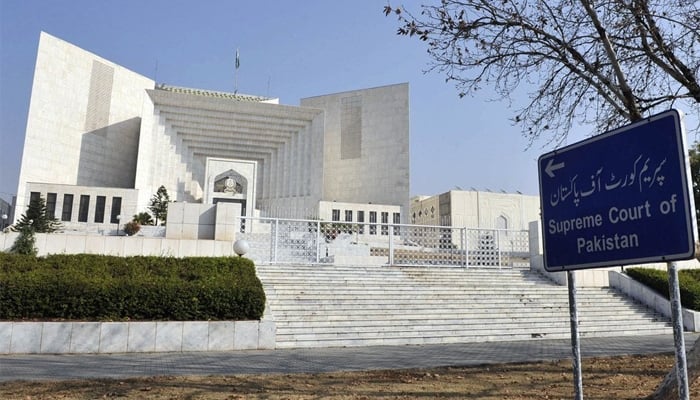Lawyers praise move to live telecast proceedings but also highlight risks
Livestreaming of court proceedings “is brilliant start and fulfilment of a long-standing position of CJ Isa", says expert
KARACHI: In a rare near-unanimous opinion across the aisle, legal experts have welcomed the Supreme Court’s decision to live telecast the apex court’s proceedings; they have however also cautioned that the move does come with some risks.
Lawyer Abdul Moiz Jaferii says that the livestreaming of court proceedings “is a brilliant start and the fulfilment of a long-standing position of CJ Isa which had come through during his petition against the reference against him. The majority had at the time decided that matters of fundamental importance ought to be televised, but that the modalities were to be decided by the administrative side of the Supreme Court, which never met on the issue. [On Monday] the full court met on the administrative side before this hearing and perhaps the same premise was decided upon which allowed the televising to be possible”.
Lawyer Waqqas Mir agrees that cameras in the courtroom make “courts accessible and bring an element of transparency hitherto unknown. Courts are the ‘safe space’ where citizens and the state argue merits of laws while judges adjudicate. More public access to and visibility on what goes on inside courtrooms is a fundamentally good thing for democracy.”
Supreme Court advocate Basil Nabi Malik says that the chief justice should be praised for this “step towards greater transparency” but cautions that “greater transparency should not be confused with greater publicity. Every judge must cater to the ends of justice without any care or consideration for any broadcast or lack thereof. Furthermore, every judge must be cautious not to get carried away with the access [the court] now enjoys with a greater audience, and in having such access, it must ensure it does not pander to the sentiments of the general populace more so than the facts of the case before it.”
However, he does add that, if done right, “Such broadcasting will go a great way in allowing people to relate to their judicial setup, understand the manner in which proceedings are conducted, and save themselves from all kinds of misinformation. All in all, demystification is perhaps just what we need.”
While lawyer Jahanzeb Sukhera calls the live streaming “an interesting experiment” and says it “gives the taxpayers an inside view of the functioning of the judicial branch and a clearer picture of proceedings”, he too adds to Malik’s words of caution. According to Sukhera, there are some risks worth considering, one of which “is that this may cause more camera induced grandstanding from both the bar and the bench. Instead of arguments and observations being limited to the extent necessary to decide a matter, we may slip into unnecessary theatrics. It may also increase the possibility of more judgments being rendered on the consideration of public perception.”
“[As we saw on Monday], cameras in the courtroom and the prospect of the nation watching does result in certain judges and lawyers playing to the gallery and there is a genuine risk that public perception may influence and motivate certain actions”, concedes Barrister Rida Hosain but adds that “While televising proceedings is undoubtedly a double-edged sword, it is a case where the good outweighs the bad. It is open justice in the true sense”.
Lawyers also understand that at the moment there may be some confusion regarding what cases will be televised and which will not and who will get to decide these matters. Jaferii is of the opinion that “All fundamental rights issues must be available for viewing, especially in Pakistan where so many fundamental rights are so frequently in flux. Any other matters considered important by the court can be optionally televised where they concern enough people.”
For Malik, “It goes without saying that any large-scale live streaming programme should be subject to thorough scrutiny and detailed SOPs, with the object being to increase transparency whilst also protecting the rights and interests of private parties. Keeping this in mind, it may be worthwhile to limit such streaming initially to specific public interest matters.”
This issue would be resolved easily, says Sukhera, “if the Supreme Court (Practice and Procedure) Bill 2023 is upheld...The committee deciding whether or not to fix the case can very well decide whether or not to televise it. Further, if the bench hearing the case so decides, the broadcast can also be cancelled if the circumstances so require”.
On the concern raised by some that TV channels could easily selectively play clips of the live telecast of court proceedings, Sukhera agrees that “there is a valid concern regarding channels and other media outlets showing clips out of context to affect public perception. This can be dealt with in two ways. First, the legislature may want to grant a copyright in the content to the Supreme Court or to the state television. This way the owner of the copyright can regulate the use of the footage more effectively. Second, if the clips are presented in a manner that is egregious enough to hamper the administration of justice, the court can keep media outlets in check through its contempt powers.”
Jaferii says that Monday’s “enthusiasm on private [TV] channels was due to the novelty of the proceedings, rather than any order or command. I feel that the publicly owned PTV can dedicate one of the channel streams to such coverage, whilst private channels are obviously free to broadcast whichever parts they feel necessary.”
There would be no harm in experimenting with different models as well, suggests Mir: “Courts can initially invite channels to consider streaming various cases. Market forces and viewership will of course play into what a private TV channel decides to show. Eventually, the courts in my view should livestream proceedings of each case from their website. We see it in India now and it’s working well. It will help litigants as well as other consumers of the justice system.”
Hosain too says that there are a number of options: “In the UK, a live video link of the Supreme Court proceedings is made available on the website of the court. In contrast, the US only provides an audio recording and transcript of the proceedings. These are both effective ways of preventing distorted reporting of proceedings. Regardless of the procedure we adopt, virtually every mainstream television channel in the country broadcasting proceedings is not sustainable in the long term”.
A separate channel may be too much, says Malik who feels that “the process by which streaming is normalized will take much time and even greater effort. I suspect that if this were to go ahead, it would be through an incremental process. Even otherwise, court proceedings do not take place throughout the day, and hence, operating a separate channel simply for this may not make much commercial or practical sense.”
-
 Blake Lively Gushes She And Ryan Reynolds Are 'partners In Everything'
Blake Lively Gushes She And Ryan Reynolds Are 'partners In Everything' -
 Teyana Taylor Reflects On Co-parenting Journey With Ex Iman Shumpert
Teyana Taylor Reflects On Co-parenting Journey With Ex Iman Shumpert -
 Blake Shelton Recalls Being 'nervous Wreck' On Adam Sandler Film
Blake Shelton Recalls Being 'nervous Wreck' On Adam Sandler Film -
 Prince Harry's Lawyer Tells Court Daily Mail Complicit In Unlawful Acts
Prince Harry's Lawyer Tells Court Daily Mail Complicit In Unlawful Acts -
 Meghan Markle Named In Epstein Files With Ghislaine Maxwell?
Meghan Markle Named In Epstein Files With Ghislaine Maxwell? -
 Drunk Driver Tries To Snatch San Diego Deputy’s Gun During Chase
Drunk Driver Tries To Snatch San Diego Deputy’s Gun During Chase -
 After Surgery, Piers Morgan Reminded Of His Remarks About Meghan's Father's Hospitalization
After Surgery, Piers Morgan Reminded Of His Remarks About Meghan's Father's Hospitalization -
 Idris Elba Gets Honest About Managing Real-life Hijack Situation
Idris Elba Gets Honest About Managing Real-life Hijack Situation -
 Royal Family Buries King Charles' Cousin
Royal Family Buries King Charles' Cousin -
 Elizabeth Hurley Faces An Impossible Choice As Son Damian, Beau Billy Ray Cyrus Clash
Elizabeth Hurley Faces An Impossible Choice As Son Damian, Beau Billy Ray Cyrus Clash -
 Rare Pokémon Cards Worth $100k Stolen In New York Shop Robbery
Rare Pokémon Cards Worth $100k Stolen In New York Shop Robbery -
 Chevy Chase Shares Disappointment After 'SNL50: The Anniversary Special' Snub
Chevy Chase Shares Disappointment After 'SNL50: The Anniversary Special' Snub -
 Samuel L. Jackson's Old Movie Found New Life: Here's How
Samuel L. Jackson's Old Movie Found New Life: Here's How -
 Nobel Prize Snub Hardens Donald Trump's Tone On ‘peace’
Nobel Prize Snub Hardens Donald Trump's Tone On ‘peace’ -
 What's Prince Harry's Case Against The Daily Mail's Publisher?
What's Prince Harry's Case Against The Daily Mail's Publisher? -
 'Matilda' Star Mara Wilson Breaks Silence On AI's 'deepfake Apocalypse' After Being Abused
'Matilda' Star Mara Wilson Breaks Silence On AI's 'deepfake Apocalypse' After Being Abused




